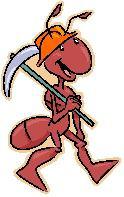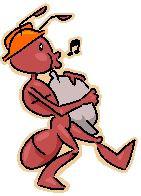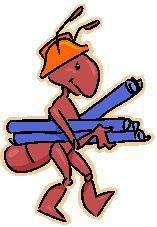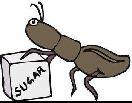Natural Solutions to Things That Bug You (10 page)
Read Natural Solutions to Things That Bug You Online
Authors: Myles Bader

Life cycle of fire ants
There are four stages to a fire ant's metamorphosis:
1.
Egg – They are laid by the queen and are small and white. They can be deposited throughout the year, but mostly deposited during the summer months. The eggs are divided into two types: Unfertilized – become winged males who mate with the queens and fertilized, which become female workers which and are either: winged virgin queens or worker fire ants, divided into different duties in the nest.
2.
Larva – These are light in color and immobile, they depend completely on the worker fire ants for transportation, protection, and food.
3.
Pupa – These are mature larvae that transform into pupae and pupate for several weeks. Worker fire ants continue to protect them until the adults emerge.
4.
Adult – They are social insects, like bees and wasps, and duties are divided among different types (castes) of adults. Total time from the egg stage to adult fire ants averages 30 days. Worker fire ants can live up to 180 days.
What fire ants eat
Fire ants will eat almost anything since they are omnivores and will eat any plant or animal material, including other insects, ground-nesting animals, mice, turtles, snakes, young saplings, seedlings, plant bulbs, fruit and grass.
When they forage for food, the oldest and most expendable 20% or so of the colony’s workers explore within 50-100 feet of the nest in a looping pattern.
Worker fire ants can chew and cut with their mandibles, but can only swallow liquids. When they find liquid food in the field, they swallow it to one of their two stomachs. One stomach saves food to share with the colony and the other one digests food for themselves. They cut solid food into carrying size and bring it back to the colony for "processing."
Fire ants prefer protein foods (insects and meats) but will feed on almost anything and everything. By regurgitating their food from the one stomach, fire ant workers are able to share it with the colony.
Other ants lick or suck up the liquid and the nest is fed equally. This food sharing is why slow-acting poison baits can be very effective in eradicating the colonies.
When they invade an area, they do it with a vengeance and their sheer number can dramatically reduce populations of native ants, other insects, and even ground-nesting wildlife. They also invade homes, schools, sand boxes, athletic fields, golf courses and playgrounds. They will cause damage to crops and electrical equipment, costing millions of dollars each year in repairs and eradication.
Fire Ant Facts:
Fire ants are capable of digging up over 16 billion tons of dirt every year, which would fill at least 3 billion dump trucks.
Ant fossils date back to the time of the dinosaurs
They are the strongest of any animal on earth and able to lift 5 times their weight
Fire ants are social insects
They cannot survive very long without the colony
How fire ants communicate
They communicate through signals and pheromones (which are chemical substances excreted by insects). They play an important role in the complex organization of fire ant societies.
Fire ants tend to spend most of their time in direct contact with the ground and when a worker comes across food she will leave a trail along the ground, which in short time other fire ants will follow. When they return home they reinforce the trail, bringing other fire ants, until the food supply is depleted. Once the food supply is gone, the trail is not reinforced and slowly disappears.
When the violent death of a fire ant occurs, it will emit an alarm pheromone that in high concentration sends other fire ants into the vicinity and into attack frenzy, but in lower amounts, just attracts them. A few fire ants use what is referred to as propaganda pheromones to confuse their enemies.
Fire ants, like other insects, use their antennae to smell as well as provide information about direction. With the use of pheromones, fire ants are able to exchange information about one another's health and nutrition. Fire ants can also detect what task group each other belongs to.
The queen is also able to communicate with the workers to determine which one will begin raising new queens.
The importance of fire ant senses
Touch:
If a fire ant is hungry, they will stroke each other or tap one another with their antennae asking for food.
Taste:
Fire ants will trade food with each other by mouth to mouth exchange. This is their method of sharing nutrition and chemicals and saying that they are related.
Smell:
Fire ants will use their antennae to smell the pheromones that come from other fire ants, which warn of danger or just say “hello” and inspire other fire ants to work harder.
Sound:
If a fire ant gets trapped in a cave-in, they will rub the joint between its waist and abdomen and produce a squeaky sound, which alerts the other ants saying “help me.” The other ants will hear the noise through their legs and come to help.
Sight:
Fire ants have two compound eyes, which have multiple lenses and they see things broken up like a kaleidoscope therefore seeing movement better than shape. Since they are underground they do not rely on sight for communication.
THE SOUTHERN FIRE ANT
The southern fire ant was accidently introduced into the Unites States in 1929, when a cargo ship used soil as ballast arrived at the port of Mobile, Alabama from South America. The problem became worse in North America since we do not have as many natural enemies as the ant has in South America.
They are commonly found in Alabama and Florida but can also be found in 12 other states as well as Puerto Rico. Some have even been found in California and Kansas.
Somehow they have even found some in the state of Hawaii. However, they cannot survive in freezing temperatures for more than 2-3 weeks.
NATURAL HERBAL REMEDY
These ants can easily be driven away by scattering the herb “sweet fern “
Comptonia asplenifolia”
around where they are frequenting. This is not really a true fern but a small shrub. Check with your local garden store for more information.
SULFUR WORKS GREAT
If your place small bags of sulfur in areas that the red ants frequent; you will never see them again.
Be careful around animals and children.



HARVESTER ANT
General Information:
These ants live mostly in western North America and they will build very large mounds. They live mainly in grasslands and are rarely found near buildings or gardens. Harvester ants love seeds as their preferred food and if annoyed will sting if their colony is disturbed.


PHARAOH ANT (sugar ant)

Identification:
 Very small (approximately 1/16
Very small (approximately 1/16
inch long or 2.0 millimeters) light yellow to reddish brown ant with the hind portion somewhat darker color and sometimes banded. The petiole, which is the narrow waist between the thorax and abdomen, has two nodes and the thorax has no visible spines.